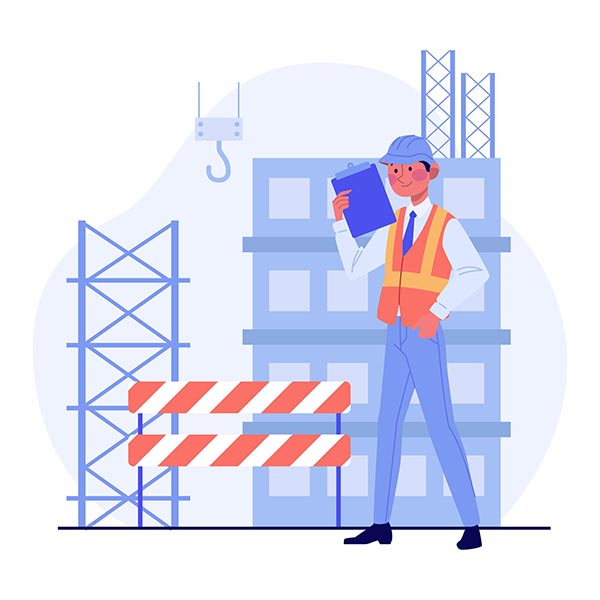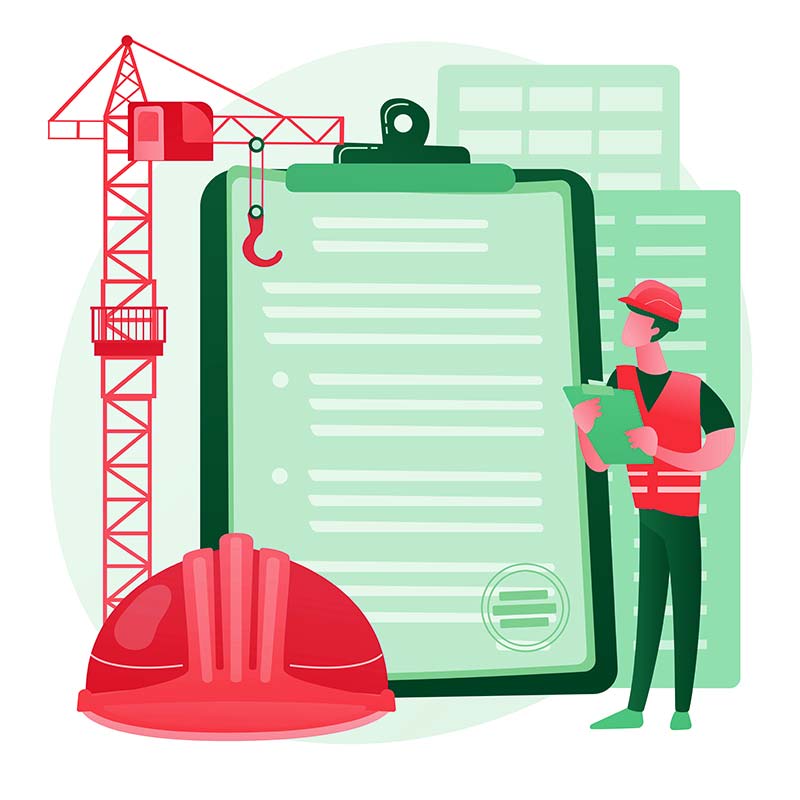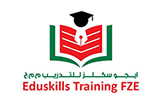HSE Plan for Workplace Safety and Compliance in UAE
A well-structured HSE Plan is the backbone of workplace safety and regulatory compliance in the UAE. It outlines how businesses protect workers, manage risks and meet legal requirements across
Risk assessment in construction is more than a regulatory requirement; it is the foundation of occupational health and safety in one of the world’s most hazardous industries. Every project site in the UAE involves risks, from working at heights and operating heavy equipment to handling hazardous materials. Without a structured assessment, these risks can turn into serious incidents, costly delays, or even legal consequences. By integrating systematic risk assessment into daily operations, companies in Dubai, Abu Dhabi, Sharjah and across the region not only protect their workforce but also improve efficiency and credibility. At Eduskills Training, we focus on equipping organizations with practical strategies that transform compliance into a culture of safety and long-term success in the construction sector.
Construction projects are dynamic, fast-moving, and often unpredictable. Without proper planning, the same factors that drive progress can create hazards capable of causing severe injuries, financial losses, or reputational damage. This is why risk assessment for construction is not just a formality — it is the cornerstone of occupational health and safety. By identifying threats before they escalate, businesses can safeguard their workforce, meet client expectations, and maintain compliance with UAE laws and international standards.
Every construction site is a high-risk environment because multiple activities take place simultaneously. Workers may be installing scaffolding at height, operating cranes, welding, or handling chemical substances — often within close proximity. The complexity of these tasks increases the chances of accidents if hazards are not assessed and controlled. A comprehensive risk assessment highlights these overlapping risks, allowing project managers to implement targeted safety measures. This proactive approach is essential in regions like Dubai and Abu Dhabi, where large-scale projects demand rigorous occupational health and safety systems.
Construction hazards are varied, but many are predictable and can be prevented with proper planning. Typical risks include:
When these risks are left unmanaged, the result can be workplace injuries, costly project delays, or in the worst cases, fatalities. By conducting regular and structured risk assessments, organizations can reduce these hazards significantly, therefore ensuring smoother and safer project execution.
In the UAE, construction companies are legally obligated to prioritize worker safety under labour laws and health and safety regulations. Authorities in Dubai, Abu Dhabi and Sharjah enforce strict compliance measures, and failure to meet these requirements can lead to penalties, project shutdowns, or loss of contracts. Risk assessment serves as the bridge between occupational safety and legal compliance because it provides documented proof that hazards are identified, evaluated, and controlled. Moreover, aligning with international standards like ISO 45001 strengthens credibility with clients, regulators, and international partners. At Eduskills Training, we help companies integrate these standards into their operations, ensuring compliance while building a culture of safety excellence.
“A construction risk assessment is not a one-time checklist—it is a cycle of identifying hazards, measuring their impact, applying strong controls, and continuously monitoring to keep every worker safe and every project on track.”

A proper risk assessment for construction follows a structured process that ensures hazards are identified, analyzed, controlled, and continuously monitored. Skipping or rushing through these steps often leaves workers exposed and projects vulnerable to accidents or regulatory action. When performed thoroughly, each step not only reduces risks but also strengthens overall occupational health and safety management.
The first step is to recognize hazards before they become incidents. On construction sites, hazards can be physical, chemical, biological, or ergonomic. Effective identification requires site inspections, worker consultations, and reviewing previous accident reports. For example, unstable scaffolding, live electrical wires, or unguarded machinery are hazards that must be flagged immediately. By systematically identifying these risks, construction managers in Dubai, Abu Dhabi, and other regions create the foundation for a safer project environment.
Once hazards are identified, the next step is to evaluate how likely they are to occur and how severe the consequences could be. This is typically done using a risk matrix that measures probability against impact. For instance, falling from a height may be less frequent than minor cuts but has far greater severity. Prioritizing risks based on severity ensures that critical hazards are controlled first. This structured evaluation makes occupational health and safety efforts more effective and aligned with both business and legal priorities in the UAE.
After evaluation, companies must put controls in place to minimize or eliminate risks. Control measures often follow the hierarchy of control:
In the UAE construction industry, implementing these controls is not just good practice — it is often a contractual and regulatory requirement. Training workers to follow these protocols through Eduskills Training ensures safety measures are practical and consistently applied.
Risk assessment is not a one-time exercise. Construction projects evolve daily, and with each new stage come new hazards. Continuous monitoring through site inspections, safety audits, and worker feedback keeps the assessment relevant. Regular reviews ensure that previously controlled risks remain under control and that emerging risks are managed before they escalate. Companies that maintain this cycle of monitoring and improvement reduce accidents, avoid costly delays, and build a culture of accountability. This ongoing approach also positions them strongly during external audits or ISO 45001 certification processes.
While the steps of a risk assessment for construction remain consistent, how companies execute them determines real success. The most effective organizations adopt proven industry best practices that strengthen compliance, reduce accidents, and embed occupational health and safety into daily operations. These practices combine technology, training, and workforce engagement to make risk assessment practical rather than just a paper exercise.
Structured checklists are one of the most reliable ways to ensure hazards are not overlooked. Standardized forms guide supervisors to review critical risk areas such as scaffolding, machinery, electrical connections, and PPE usage. Increasingly, construction firms in Dubai, Abu Dhabi, and Sharjah are adopting digital tools and mobile apps that make risk assessment faster, easier to document, and accessible in real time. These platforms also provide analytics, helping companies track recurring hazards and take preventive action. By integrating technology into occupational health and safety processes, businesses stay more compliant and reduce delays caused by accidents.
Even the most detailed risk assessment fails without worker understanding and participation. Training programs ensure that employees at every level know how to identify hazards, follow safety procedures, and use protective equipment correctly. Tailored awareness sessions also help supervisors reinforce safety culture on-site. At Eduskills Training, we provide both classroom and e-learning options to make occupational health and safety training accessible across the UAE and neighboring countries like Saudi Arabia and Qatar. Well-trained workers not only protect themselves but also help prevent accidents that could put entire projects at risk.
True safety is achieved when supervisors and workers see risk assessment as part of their daily routine, not as a box-ticking task. Engagement comes from regular communication, toolbox talks, and involving employees directly in hazard identification. When workers are encouraged to report risks without fear of blame, companies gain a continuous stream of insights that strengthen occupational health and safety systems. Supervisors, on the other hand, play a key role in modeling safe behavior and ensuring protocols are followed consistently. This shared responsibility creates a culture where risk assessment is seen as a collective effort — improving safety outcomes across all levels of construction projects.
“Occupational health and safety transforms risk assessment in construction from a compliance exercise into a life-saving practice—protecting workers, driving productivity and reducing the heavy costs of accidents and delays.”

Occupational health and safety (OHS) is the backbone of every successful risk assessment for construction. It ensures that hazards are not only identified but also managed in a way that protects lives, improves efficiency, and supports long-term business sustainability. In construction, where risks are higher than in most industries, OHS-driven risk assessment creates safer sites, stronger compliance, and better outcomes for both workers and employers.
The most important role of OHS in construction risk assessment is safeguarding workers. Falls from height, heavy equipment accidents, and electrical hazards remain the leading causes of fatalities in the sector. By embedding OHS principles into risk assessment, companies ensure that control measures—such as guardrails, lockout-tagout systems, or mandatory PPE—are applied consistently. This proactive protection builds trust among employees, showing that their well-being is a top priority, while also reducing turnover and absenteeism.
A safe construction site is also a more productive one. When hazards are controlled and workers feel protected, they can focus on completing their tasks without fear of accidents. Reduced downtime from incidents means smoother project timelines and fewer disruptions. Companies in Dubai, Abu Dhabi, and Sharjah that integrate OHS into their risk assessment processes often see measurable improvements in efficiency and worker morale. This link between safety and productivity highlights why occupational health and safety should be treated as an investment rather than a compliance burden.
Accidents on construction sites come with high costs—medical expenses, compensation claims, project delays, and even reputational damage. Risk assessments that prioritize OHS help prevent these costly disruptions by addressing hazards before they cause harm. In addition, compliance with occupational health and safety laws in the UAE reduces the risk of fines or legal action. Over time, fewer accidents mean lower insurance premiums and stronger financial stability. By making OHS central to risk assessment, construction firms not only save lives but also protect their bottom line.
Choosing the right training partner makes a significant difference in how effectively a company manages risk assessment for construction. At Eduskills Training, we go beyond theory to deliver practical, industry-relevant solutions that fit the realities of construction projects in the UAE and the wider region. Our focus is to help organizations strengthen occupational health and safety, meet compliance requirements, and build safer workplaces without unnecessary complexity.
Our trainers are not just academics; they are seasoned professionals with years of hands-on experience in construction, oil and gas, and manufacturing. This means the training we provide is grounded in real scenarios that workers and supervisors face on-site every day. Whether it’s identifying hazards, applying the hierarchy of controls, or preparing for ISO 45001 audits, our experts translate international best practices into simple, actionable steps. This industry insight makes Eduskills Training a reliable partner for organizations that want practical results in occupational health and safety.
We understand that construction companies operate under tight budgets and demanding schedules. That’s why Eduskills Training offers affordable programs designed to deliver maximum value without compromising quality. Businesses can choose classroom sessions for in-depth interaction or e-learning modules for flexibility across distributed teams. This blended approach ensures that workers in different shifts or sites can still receive consistent training, making risk assessment a shared responsibility across the organization.
Our reach extends across the UAE, covering Dubai, Abu Dhabi, Sharjah, and neighboring regions such as Saudi Arabia and Qatar. This makes it easier for multinational contractors, local firms, and SMEs to train their teams under one trusted provider. By tailoring programs to regional regulations and project requirements, Eduskills Training ensures that risk assessment aligns with both local compliance and international occupational health and safety standards. This wide accessibility reinforces our mission to make safer construction environments a reality across the Gulf region.
Effective risk assessment for construction is not just about compliance—it is about building a culture where safety and productivity go hand in hand. From identifying hazards on-site to empowering workers through training, every step of the process plays a role in protecting lives and improving outcomes.
By following industry best practices and prioritizing occupational health and safety, construction companies across Dubai, Abu Dhabi, Sharjah, and the wider region can reduce accidents, avoid costly delays, and strengthen their reputation. Partnering with Eduskills Training ensures access to expert trainers, affordable and flexible learning options, and tailored programs that meet real industry needs. Together, we can create safer worksites and a more sustainable future for the construction sector.
Risk assessment in construction is the process of identifying, evaluating and controlling workplace hazards to ensure safety and compliance.
It prevents accidents, protects workers, and ensures projects are delivered on time without costly disruptions.
They should be conducted before starting a project and reviewed regularly, especially when conditions or tasks change.
Common hazards include falls, machinery accidents, electrical risks, chemical exposure and poor ergonomics.
Yes, safety checklists and digital apps make it easier to document hazards, track actions and update assessments in real time.
Fewer accidents and less downtime mean smoother project workflows, higher efficiency and better worker morale.
Their practical insights improve hazard identification and encourage ownership of safety culture.
Eduskills Training provides expert-led courses, affordable learning options and practical guidance tailored to construction projects.
A well-structured HSE Plan is the backbone of workplace safety and regulatory compliance in the UAE. It outlines how businesses protect workers, manage risks and meet legal requirements across
Risk assessment in construction is more than a regulatory requirement; it is the foundation of occupational health and safety in one of the world’s most hazardous industries. Every project
How to Conduct a Successful ISO 9001 Gap Analysis for Your Business? Conducting an ISO 9001 Gap Analysis in UAE is the smartest way to understand how close your
In 2025, clients, regulators and global partners are watching more than just your certificates. They want to know whether your team genuinely committed to health and safety or just
Many companies say they “comply with safety standards.” That’s not the same as having a safety-first culture. Compliance is a checklist. Culture is a mindset. When safety becomes part
Dubai’s business ecosystem is booming, but so is the demand for proven quality. Customers—especially corporate and government clients—are no longer impressed by just promises. They want proof. And ISO
In a world rapidly shifting toward sustainability and environmental compliance, professionals who can lead this change are in high demand. Whether you're based in the UAE or the broader
If you're working in health and safety and looking to move forward in your career, the Qualifi Level 7 Diploma in Occupational Health and Safety Management is one of
ProQual NVQ Level 7 Diploma in Strategic Health and Safety Leadership and Management by Eduskills Training is a competency-based qualification designed for professionals looking to enhance their expertise in
ISO 45001 is an international standard for Occupational Health and Safety Management Systems (OHSMS) designed to improve workplace safety, reduce risks and enhance employee well-being. Introduced by the International
The benefits of ISO 50001 certification go far beyond just meeting international standards—they empower businesses across the UAE and GCC to drastically cut energy costs, boost operational efficiency and
ISO certification in UAE has become more than just a professional badge — it’s a powerful tool for building trust, credibility and long-term success. As the UAE continues to
The importance and benefits of ISO 14001 certification extend far beyond regulatory compliance—they position businesses as responsible and sustainable entities in a world where environmental concerns are at the
When considering the benefits of the IOSH Managing Safely course, particularly in high-risk industries such as construction, oil and gas, manufacturing and healthcare, it’s clear that IOSH Managing Safely
ISO 9001 certification in UAE is a cornerstone for organizations striving to establish and maintain an effective Quality Management System (QMS). ISO 9001 is internationally recognized standard symbolizes a
If you're aiming for a senior role in health and safety management, understanding the guidelines for ProQual NVQ Level 7 diploma is essential. This advanced NVQ Level 7 Diploma
NVQs (National Vocational Qualifications) in the UK are equivalent to various academic qualifications depending on their level.
Copyright @Eduskills Training FZE | All rights reserved.
